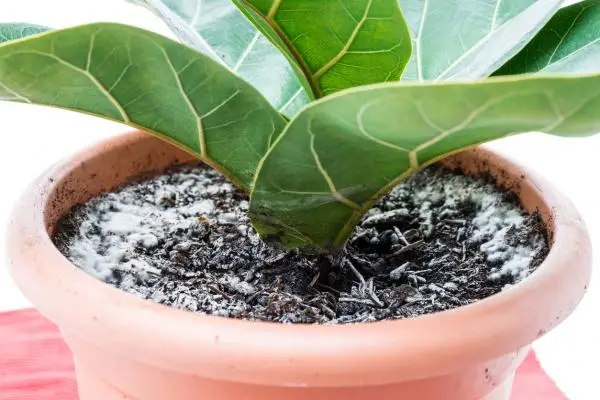It is very common to see a whitish layer of mold appear on the substrate of plants, especially when it comes to indoor potted plants and the substrate is a previously acquired mixture. And while it is normal to panic when you discover white mold in plant soil, it does not always mean something necessarily harmful: in small amounts, certain molds can even be beneficial by hindering the development of other undesirable elements for plants. Even so, when the mold colonizes the entire substrate, it must be eliminated because it becomes a danger to the plant. If you want to know the causes of white mold in plant soil and how to eliminate or prevent it, join us in this article.
Why does white mold grow on the ground
The first thing you need to know is that not every time you see a whitish layer on top of the soil in your pot it is mold. It is very common that, especially when irrigated with running water, the earth accumulates over time a small deposit of salts and lime. This is because the plant absorbs nutrients and water from the soil, leaving behind these substances that it does not need. At first, it will look like a kind of whitish velvet, but as it accumulates it will end up becoming a brittle layer, which is very easy to remove with your hands or by removing the first centimeters of the substrate and then put on a little new one.
If, on the other hand, the whitish layer is wet, it is white mold in the soil of the plants
. It is also easy to identify by the way it spreads: if it quickly colonizes the entire substrate or even the plant, it is undoubtedly fungi.It is very common for this to appear in the mixtures of substrates with nutrients since they result in an environment that also favors its development. This will appear in the soil when the humidity and temperature conditions are high, which together with the nutrients of the substrate will promote the growth of mold.
In the case of saprophytic molds, they only feed on dead plant matter, so they do not pose any danger to the plant or to people. In any case, an exceptional accumulation of them could form a thick layer on the substrate, making it difficult for the plant to absorb water by retaining it. In these cases, it will also need to be removed.
How to remove white mold in plant soil
If it is not known what type of molds appear on the substrate, and these grow too much or generate bad odors, it is best to remove them just in case. Some cases of mold in the soil of the plants can be harmful and attack our plants.
If there is mold in the pot itself, a thorough cleaning will be necessary. Start by removing the root ball from the pot and carefully shake off as much soil as possible from the roots. If these are affected by mold, you can also prune them. After this, it will be necessary to use a new substrate and a new container, or thoroughly disinfect the pot.
If it is not as widespread in the pot, you can use an antifungal. Organic fungicides always recommend more. For example, you can use milk dissolved in nine parts of water, sprayed daily on the substrate and the affected parts of the plant until the mold disappears.
It is also important to move the pot to an airy location and as dry as possible, as well as to reduce the risks on the plant while the treatment against fungi lasts. Without plenty of moisture, it will be much easier to get rid of mold.

How to prevent white mold in plant soil
Preventing the appearance of mold in the soil of the plants is as simple as providing those conditions that fungi do not support: aeration and little humidity
. Obviously, it is not about stopping watering the plant, but waiting for the substrate to dry slightly before watering again will be of great help. In addition, it is vital that, if the plant is in a pot, it has drainage holes so as not to accumulate water.Regarding aeration, it is enough to ensure that the plant is in a location with natural air circulation. However, some species are affected by currents, so it is not advisable to do this. In these cases, what you have to do is slightly remove the upper layers of the substrate, where we do not damage the roots. By removing and loosening the substrate, it will also naturally air out, making it difficult for fungi to grow.
It is also important to provide the plant with the necessary fertilizer, neither in excess nor in defect, and always remove the remains of fallen leaves and flowers from the soil or substrate. A good option is also to water by dish under the plant instead of spraying water from above, but remember to leave it for only a few minutes and then remove it or put the right amount of water each time, to avoid a puddle at the roots.
